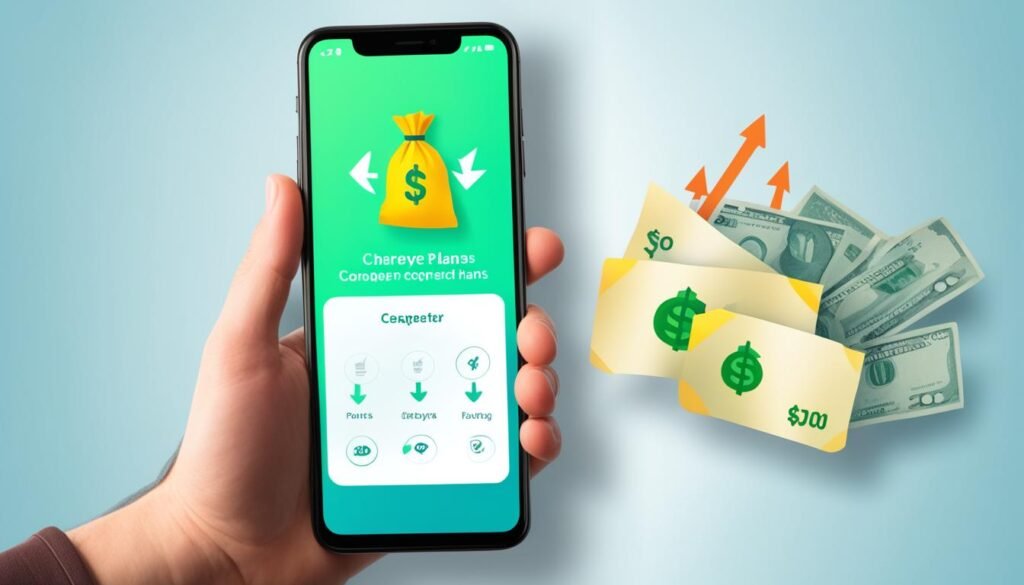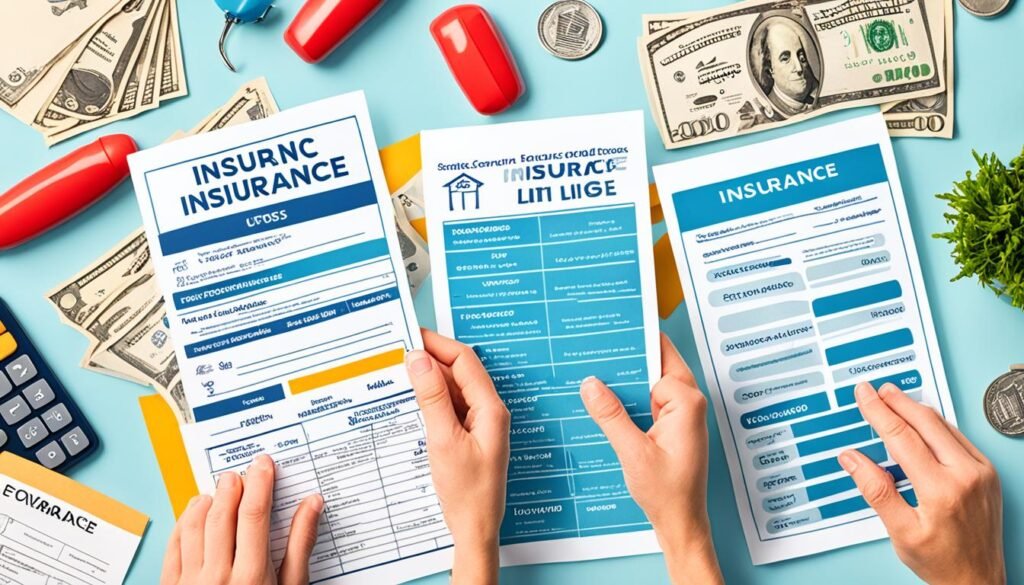Banks are making a lot of money from us. Every year, they get about $9 billion from overdraft and nonsufficient funds fees. This is just the beginning of the extra money we spend. Bankrate’s 2023 study showed that almost half of non-interest checking accounts are free. But many still get charged monthly fees. It’s time to look at our money habits and find ways to keep more of it in our pockets.
Small changes in our daily habits can make a big difference in our finances. Start by setting up automatic transfers and being careful with how you shop for groceries. Eating at home more often also saves a lot. By using these simple tricks, you can meet your short-term money goals. Plus, you’ll be on your way to being financially secure in the long run.
Key Takeaways
- Automated transfers simplify saving and ensure consistency.
- Planning and utilizing loyalty programs can optimize grocery expenses.
- Dining in more frequently helps control food costs.
- Lowering energy consumption can significantly reduce monthly utility bills.
- Reviewing and canceling unnecessary subscriptions can cut recurring expenses.
Automate Transfers to Save Effortlessly
Setting up automated transfers through financial apps can really boost your money game. By doing this, you make saving easy and avoid the urge to splurge. It’s like putting saving on autopilot.

Set Up Regular Transfers
Start by automating regular savings from your checking into your savings account. This simple step means you save without even noticing. Imagine, just $100 a week can build up to thousands in a year.
These automated moves help you stay steady on your financial path. They can be perfect for saving up for big things like a home or your retirement. You get to pick how much and how often to save, fitting it perfectly to your life.
| Type of Automated Savings | Description | Suitable For |
|---|---|---|
| Account Transfers | Transfers between checking and savings as often as you choose. | Those who like saving the same amount regularly. |
| Direct Deposits | Parts of your pay directly sent to your savings. | Ideal for people with regular paychecks. |
Use Automated Savings Apps
Apps like Digit and Qapital can save small bits from checking to savings for you. This way, you don’t even miss the money. It’s a cool way to save without feeling it.
Then you’ve got Acorns or Stash, which can turn your pennies into investments. They use the change from spending on stuff and invest it for you. These apps are great for smart, automated saving and investing.
Using these saving tips and tools can really help your financial future. Look into savings accounts that grow fast and have good online features. This combo can really push your savings and boost your financial discipline.
Optimize Your Grocery Shopping
Inflation is high, but you can still save a lot of money. Optimizing how you shop for groceries is key. You can save big by making lists and using loyalty rewards.
Make a Grocery List
A grocery list is the first step to saving money. It helps you avoid buying things you don’t need. This is important because the prices of food at home have gone up by 11.3% in the last year. A list will keep your spending under control and help you live frugally.
Use Coupons and Loyalty Programs
Coupons and loyalty programs are great for getting discounts. For example, some credit cards give you cash back or rewards at the grocery store. You can find special deals in the Sunday paper. And, loyalty programs often email you special offers. All these can help you save more money.

Buy Generic Brands
Choosing generic brands saves you a lot of money. They cost less but are just as good as name brands. By picking generics, you cut down on your spending. This is especially helpful when prices for items like cereals and dairy have gone up a lot.
Remember, these saving tips will help you deal with high prices. Use discounts and rewards to your advantage on every grocery trip. This way, your bill won’t be as high.
Trim Your Entertainment Expenses
Looking for ways to save money on fun? Start with cost-effective options. Try attending free community events. This way, you can have a full social calendar without the big price tag. Many places offer free fun, like museums, parks, and community centers.

Take Advantage of Free Community Events
Getting involved in your local community’s free events is a smart move. Parks and recreation departments often host these events. From outdoor music to movie nights and art shows, there’s plenty to do without spending much. Plus, these events are enjoyed by all, young and old.
- Local festivals, flea markets, and garage sales offer budget-friendly fun.
- Libraries provide free access to books, movies, and CDs.
- Check out free admission days at national parks to reduce costs.
Utilize Discounts for Movies and Parks
Looking to save more on entertainment? Don’t forget about discounts for movies and parks. Movie theaters often have cheaper tickets for early shows. Then, there’s AMC A-List and similar programs that make watching a lot of movies more affordable. Parks and recreation spots also have deals for students, military, and seniors, lowering the cost of fun even more.
- Opting for matinee movie showings helps save on ticket prices.
- Explore movie subscription services like Hulu and HBO Max with student discounts.
- Seek out discount activities in national parks, museums, and local attractions.
Minimize Eating Out
Cooking at home often saves a lot of money. You’ll see how much you save by comparing the cost of eating out to cooking at home.
Cook at Home More Often
Choosing to cook at home is a great way to be frugal. Eating out usually costs about $20 per meal. But, if you cook at home, it’s around $4. So, think about the money you save every month.
Let’s say a family of four ate out three times a week at $15 each. They could save $480 by cooking meals that cost $5 per person.

Effective Meal Planning
Meal planning is key to saving money at the grocery store and not wasting food. It’s good for both your budget and your health. Try a challenge of not eating out to save $50 to $150 if you dine out less. Planning meals also stops you from buying food just because it’s easy, which can be expensive.
| Expense Type | Cost per Meal | Monthly Total (Family of Four) |
|---|---|---|
| Restaurant Meal | $20 | $480 |
| Home-Cooked Meal | $4 | $96 |
| Potential Monthly Savings | $384 | |
Learn to cook more at home and plan your meals well. These efforts will benefit your finances and overall well-being.
Reduce Utility Bills
Lowering utility bills can help you better manage your expenses at home. By using energy-saving tips and getting good deals on cable bundles, you can save a lot of money. All this, while still being comfortable and enjoying your home.

Lower Electric Bill
There are many ways to cut down on your electric bill. First, invest in appliances and LED lights that use less energy. Products with an Energy Star label can use up to 65% less power.
LED lights save a lot of money too. They can cut your lighting costs by $225 each year compared to old bulbs.
Another great idea is to use a smart thermostat. Changing its setting by 7 degrees can save you 10% on heating and cooling. Smart thermostats and Energy Star lightbulbs also help reduce costs.
Don’t forget simple things. Change air filters in appliances every few months. This helps them work better and saves money. And remember to unplug devices that use power even when off. This alone can save you $200 a year.
Solar panels are a big choice for big savings. They can pay for themselves in 6 to 12 years. After that, you save a lot on your bills.
Bundle Cable and Internet
Looking into cable bundles is smart for saving money. Bundling cable and internet can lower your monthly costs. It also makes paying bills easier and might come with good deals.
Making smart choices about how you use utilities can lead to significant savings. These savings not only help your budget but they are also good for the planet. It’s a win-win.
Switch Your Cell Phone Plan
In today’s fast-paced world, it’s key to watch your spending on phones. Saving money on your cell plan is smart. Americans often pay much for service, an average of $906 yearly per person or $1,281 yearly for a couple.

Look for Cheaper Plans
Saving big starts with checking out different plans. Families sometimes pay over $2,000 a year. Mint Mobile has a $15 first three-month plan or Tello offers customized plans from $10. These can save you a lot.
For those with kids, T-Mobile’s $105/month Essential Unlimited plan might be great. It includes unlimited talk and text, 5G, and 50GB high-speed data. Visible offers unlimited everything at $25 first month, then $40. Families of four can save about $930 a year by switching their plan.
Here’s a quick look at plan costs:
| Carrier | Plan | Cost per Month |
|---|---|---|
| T-Mobile Essential Unlimited | $105 (family of four) | |
| Verizon Unlimited Elite | $50 (per line for a family of four) | |
| Mint Mobile | $15 (first three months) | |
| Tello | $10 (customizable plan) | |
| Visible | $25 (first month), $40 (subsequent months) |
Sign Up for Autopay
Autopay can get you even bigger discounts, which is great for saving. Many carriers like T-Mobile and Verizon give $5 to $10 off each line monthly. For a family, this means up to $20 in savings with T-Mobile’s autopay deal.
Check your cell plan regularly and use autopay to lower costs. This way, you’ll pay less each month and see big savings over time.
Utilize Cashback and Rewards Programs
Make cashback credit cards and rewards subscriptions part of your money plan. They can bring you financial perks and rewards when you buy stuff. Picking the right ones for your spending helps you save money and enjoy extra benefits.

Cashback Credit Cards
Big cashback offers come with the right rewards credit cards. With the Affinity Cash Rewards Visa Signature Credit Card, you get 5% off on Amazon and book buys. You also snag 2% at places like supermarkets, restaurants, gas stations. Everything else gets you a 1% discount. Plus, you get a $200 cashback bonus if you spend $3,000 in the first 90 days.
To make the most of these benefits, always pay your bill in full each month. Knowing where most of your money goes helps. Pick a card that rewards you well in those areas. This can really up your savings game.
Rewards Program Subscriptions
Joining loyalty programs that match what you buy can boost your rewards. These programs offer points, miles, or money back. Go for ones that give more in categories you use the most. For example, the Affinity’s Cash Back Debit Card earns you 1% cash back on your debit buys. It’s a simple way to earn a little extra all the time.
Also, use shopping portals, special deals, and cashback apps for more rewards. Compare different cashback options to find the best for you. Cashback websites work with a lot of stores. They give you money back for buying through them. This adds to your saving efforts.
| Card/Program | Cashback Offers | Bonus Offers |
|---|---|---|
| Affinity Cash Rewards Visa Signature | 5% on Amazon & bookstores, 2% on supermarkets, restaurants, gas stations, 1% on other purchases | $200 bonus for $3,000 spend in 90 days, 20,000 points for $20,000 spend in 12 months |
| Affinity Cash Back Debit Card | 1% on all debit purchases | None specified |
Cancel Unnecessary Subscriptions
Keeping track of your subscriptions can save you a lot of money every month. It’s important to look through them regularly and cancel what you don’t need. This is key for managing your finances well.
Review Monthly Bank Statements
To see if you’re paying for subscriptions you forgot about, go over your bank statements every month. You might find charges you didn’t remember. Things from Amazon, Apple, and Google often hide these charges.

- Amazon Prime and Prime Video subscribers seeing ads unless they opt to pay more.
- Netflix implementing controls on password-sharing.
- Disney modifying terms to restrict account sharing.
Take a closer look at your app store subscriptions too. For iOS, go to your profile and choose “Subscriptions.” Android users, go to the Play Store. Amazon users, look in “memberships and subscriptions.” This check can stop you from paying too much.
If you don’t need a service anymore, unsubscribe right away. Just search for the company plus “cancel account”. If it’s hard, contact customer service. Or tell your credit card company about charges you don’t recognize.
Keep a list of all subscriptions. Set reminders to cancel free trials before they charge you. Checking your bank statements often is another way to keep control of your money. This way, you’ll have more money for the things you really want.
Tips to Save Money Fast
In today’s world, it’s vital to find ways to save money quickly. Try to cut out one area where you spend money needlessly. Also, taking on challenges like not spending money can boost your savings fast.

Eliminate One Spending Habit
A J.D. Power survey showed 60% of people use at least four streaming services. Stopping one of these can save you a lot. For instance, not buying a coffee every day could save you $20 weekly, which is $80 a month.
Another simple change is making your lunch instead of buying it. This can save you $50 to $100 each week. These small steps can really add up over time.
Try a No-Spend Day
A no-spend day can help you be smarter about your money. It makes you question if you really need to spend on certain things. For instance, staying in for drinks or renting movies instead of going to the cinema can save a lot of cash.
| Spending Habit | Potential Savings |
|---|---|
| Skipping Daily Coffee Run | $20/week ($80/month) |
| Packing Lunch Instead of Buying | $50-$100/week |
| Movie Rentals Over Cinema | $10-$15 per ticket |
These quick saving tips really work. A recent APA study found that 83% of adults worry a lot about inflation. By saving more, you can fight this financial fear. This will help you reach your dreams sooner.
Maximize Your Savings with Budgeting
Last year’s high inflation makes planning your finances more important than ever. The 50/30/20 rule is a great way to wisely use your income. It divides your money among needs, wants, and savings. By tracking spending and sticking to a budget, your finances can get a lot healthier.

Create a 50/30/20 Budget
Try the 50/30/20 budget strategy. It says to spend 50% on must-haves, 30% on things you want, and save 20%. This setup makes sure you’re spending well and saving plenty for later. Always look at and tweak your budget. This keeps your money plan working as your life changes.
Track Your Spending
Knowing what you spend is key to find where you might be spending too much. Use tools and apps with auto-saving and detailed spending breakdowns. By setting up automatic saving and watching what you spend, you can stick to your budget and meet your money goals. Keep checking your spending patterns. Adjusting along the way can make your saving plan better over the long run.
Using these methods can bring you to spend more carefully and save better. This is true even when times are tough.
Lower Student Loan Payments
Managing student loans well is key for grads wanting to cut costs. Consider strategies like income-driven plans. The SAVE plan can be a big help. It forgives extra interest if your monthly payment doesn’t cover it all. This is great for those with lower incomes, possibly dropping their monthly cost to zero. But, if you have a Parent PLUS loan, remember, any unpaid interest can add up each year by 10%.

Another good move is to refinance. This combines several loans. You might get better rates and pay back in less time. It’s critical to keep up with federal loans; they’re at risk of default after 270 days. Auto-payments can prevent this and may get you a lower rate too.
If you’re a grad or in the military, knowing the Servicemembers Relief Act helps. This could drop your loan’s interest rate to 6%. Also, look into help from your job and any special aids for repaying. The Covid-19 loan pause is over, and interest starts back up on September 1, 2023.
Working grads can look into making extra payments to cut down on their loan faster. For instance, upping your payment from $288 to $400 a month could clear a $25,000 loan in under seven years. This greatly shortens the time you’ll owe. There are also many kinds of loan forgiveness programs, like for public service workers and teachers, that could slash your debt.
| Plan Type | Payment Based On | Repayment Term |
|---|---|---|
| Revised Pay As You Earn (REPAYE) | 10% of discretionary income | 20-25 years |
| Pay As You Earn (PAYE) | 10% of discretionary income | 20 years |
| Income-Based Repayment (IBR) | 10-15% of discretionary income | 20-25 years |
| Income-Contingent Repayment (ICR) | 20% of discretionary income or a 12-year fixed term | 25 years |
By using these tips, you can better handle your student debt. This includes payment tweaks and refinance choices. It’ll make your loans more manageable. Then, you can concentrate on your dreams without the stress of a huge debt over your head.
Optimize Car Costs
Reducing your vehicle expenses is key to keeping a budget. It’s also important for long-term financial health. You can save a lot by refinancing your car loan and finding cheap car insurance. This will lower your monthly costs.
Refinance Your Auto Loan
Refinancing can lower your monthly car payments. It can also cut down on how much you pay in interest. A better credit score might get you a lower interest rate. This means you pay less each month. Also, a bigger down payment means you’ll borrow less. Use an auto loan calculator to see how different down payments and loan terms affect what you pay each month.
It helps to use the 50/30/20 rule for budgeting. Spend 50% of your income on must-haves, 30% on fun things, and save the remaining 20%. This will make it easier to manage your finances. It also makes it simpler to focus on paying off your car loan and saving money.
Shop for Cheaper Car Insurance

Getting affordable car insurance is a big part of cutting costs. Big companies like Geico, Progressive, and StateFarm offer discounts. These include if you drive less than 7,500 miles a year or have a good driving record. Regularly looking for new insurance can help you find these deals. This way, you make sure you’re always getting the best price.
Maintaining a good credit score can bring your insurance cost down. People with the best credit scores pay a lot less than those with poor credit. Always compare different insurance quotes. Doing this can save you a lot of money on your car insurance.
Here are some insights to help you make informed decisions:
| Scenario | Impact on Costs |
|---|---|
| Car Loan Refinancing | Lower monthly payments, reduced interest |
| Insurance Shopping | Potential discounts, lower premiums |
| Drives Less Than 7,500 Miles | Insurance discounts |
| Good Credit Score | Reduced insurance costs |
| Larger Down Payment | Lower loan amount, reduced monthly payments |
Managing your car costs well demands a smart approach to loans and insurance. Making the right choices can lead to big money savings. This is good for your finances in the long run.
Bundle and Save on Insurance
Bundling your insurance policies can save you a lot of money on premiums. It’s a great way to get affordable coverage. By bundling, you can save on both home and auto insurance. Plus, you’ll only have one bill to pay.
Bundle Home and Auto Insurance
If you combine home and auto insurance, you could get big discounts. For example, American Family Insurance gives a 23% discount. Amica offers up to 30% off.
Auto-Owners Insurance matches your auto deductible to your homeowner’s if the same accident affects both. These savings tips show how bundling can meet your insurance needs cost-effectively.

Look for Discounts
When you bundle, look for extra discounts. Many companies offer bundled packages with more benefits or coverage. For example:
- Country Financial: Provides new home construction material coverage and new car replacement.
- The Hanover: Offers unique bundles like Platinum and Prestige with special discounts.
Allstate says you can save up to 25% by combining home and auto insurance. Plus, you might get a 10% to 20% discount just for having all policies with one company. Some insurers also offer life insurance with their bundles, cutting costs on all your policies.
| Insurance Provider | Bundle Discount |
|---|---|
| American Family | Up to 23% |
| Amica | Up to 30% |
| Allstate | Up to 25% |
| USAA | 10% Average Savings |
Knowing what affects your rates can help you further. Things like how much insurance you’ve purchased with them, your driving history, credit score, and how long you’ve been with them matter. Sticking with one insurance company can lead to more discounts over time.
Conclusion
Looking over saving strategies, we see managing money well involves many wise moves. These include setting up automatic savings and cutting back on unused subscriptions. A study by Ramsey Solutions found 33% of Americans have no savings, and more than half lack a $1,000 cushion. This data highlights the vital financial tips this guide has shared.
To save money, focus on everyday habits. Look at your power and water bills, how you shop for food, and ways to bundle your debts. Also, rethink which bank and credit cards you use to avoid extra fees. The 50/30/20 rule offers a way to split your budget: half on needs, 30% on wants, and 20% on saving or paying off debt. This approach helps reach long-term financial targets while still allowing for treats.
Teaching kids about saving early on is key. They often copy their parents’ money habits. By encouraging good spending practices when young, you prepare them for a stable future. Also, reviewing your spending can show where you can cut back. For instance, saving on gas by keeping your car tires inflated correctly or picking a cheaper phone plan. Applying these methods can lead to big savings. To wrap up, saving money takes ongoing effort and careful planning. So, begin now for a strong financial future.



